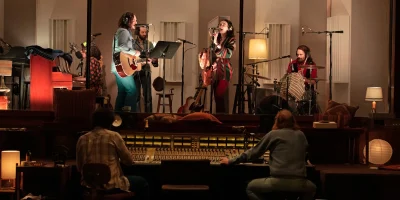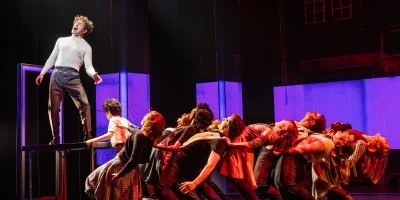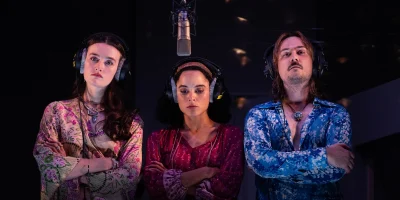
How the ‘Stereophonic’ Broadway cast transformed into real rockers
The Tony Award-nominated stars of the play with music, up for a record 13 honors in total, shared how they learned to “groove together and be a real band.”
The Broadway play Stereophonic truly rocks – and it has a record-setting 13 Tony Award nominations to show for it.
Wall-to-wall authenticity is a key reason David Adjmi’s drama about a fictional, fast-rising 1970s rock group recording a new studio album received rave reviews. The seven actors, who reprise their roles from Stereophonic's Off-Broadway premiere last fall, are completely convincing as troubled, Fleetwood Mac-like bandmates and their sound engineers. Five are up for a Tony.
“Practice, practice, practice” was required to keep it all so real, said Sarah Pidgeon, who plays singer, songwriter, and tambourinist Diana.
Over the play’s three hours, the actors sing, play instruments, and sling attitude while performing original songs by Arcade Fire alum Will Butler. It’s doubly impressive considering that Stereophonic is technically a play with music, not a musical.
Stereophonic, in a way, gives new meaning to the school of rock. Besides honing their vocal and instrumental talents (some of which they developed from scratch), the cast members each learned different skills needed to navigate a recording studio.
Setting the stage to really rock
Eli Gelb and Andrew R. Butler play engineers, whose onstage job is to make the recording sessions look as authentic as possible. “I talked to a lot of people about sound engineering. My former roommates are musicians, and I learned a lot about sound when they got into synthesizers,” Gelb said.
“The first person I reached out to when I got the role last summer was my friend Zach Abramson, who’s a composer for video games,” he added. “We went down to his car and took out this ancient live mixing console, and he gave me the rundown on all the components of a board.”
Gelb’s other resources included Wikipedia; message boards; Tape Op magazine; a book by Geoff Emerick, the Beatles’ main engineer; and Justin Craig, the show’s music director, who had Gelb mix a song with him.

Butler and Gelb also spent time with Vishal Nayak, the recording engineer for the Stereophonic cast album released on May 10. “We learned about recording to tape, the audio equipment, the workflow of the studio, and the details that engineers are managing during recording,” said Butler.
“Then we had Will Butler and Justin Craig — both experienced studio professionals — there to answer questions and provide guidance during the process,” he continued.
It also helps that set designer David Zinn and sound designer Ryan Rumery’s rendering of a late-1970s studio is steeped in reality. The onstage recording equipment, Rumery said, “are all real vintage microphones of the era. Everything that you’re hearing [the cast] sing is live.”
This means Stereophonic is never exactly the same twice, and the musical numbers “Masquerade” and “East of Eden” are reminders. At each performance, the cast performs and records the songs in real time, and Gelb and Butler play back those tracks aloud. (If the live mix malfunctions, there's a backup recording the actors can use.)
The results are subtly different each time. “If [the performers] do a little weird thing or something, you hear that,” said Rumery. “I want that to be real. I’m very proud of those two moments.”

The real art of becoming a fictional band
Transforming into rock band members was a challenge for all the actors, too. "It was important to come in with a drum vocabulary beyond what was on the page,” said Chris Stack, who plays drummer Simon, but that idea applies across the board. The whole cast dove into regular lessons to be studio-ready on stage.
Pidgeon played piano growing up, “but mainly classical,” she said. “And I certainly never played in a band.”
Juliana Canfield, who is pianist/vocalist Holly in Stereophonic and a self-described “major shower singer” in real life, played piano “under duress until the sixth grade.” Stack also last touched his instrument in middle school. Will Brill, as bassist Reg, had played guitar for a 2013 movie, but never the bass.
“I had four quick-and-dirty bass lessons where he taught me the bass line for ‘Masquerade’ and one other song,” said Brill. “That got me the job. Thereafter I had three one-hour lessons a week."
Meanwhile, the production put Tom Pecinka into guitar lessons twice weekly starting with callbacks to play guitarist/vocalist Peter. "I would send the team update videos every week so they could track my progress," he said.
Being in a band is a team effort, and each player was determined to pull their weight. Being able to do that on their own enabled the cast to find a thrilling group dynamic in Stereophonic.

Canfield took note of that shift, when individual players morphed into something bigger. “For the first several weeks of rehearsal, we played music for four hours a day," she said. "That was instrumental – no pun intended – because it helped me conquer my fear of playing and singing in public and because that’s how we learned to be a groove together and be a real band.”
Pidgeon had a similar awakening. “For a while during our music rehearsal process, we all felt quite singular,” she said. “I can’t point to an exact moment, but after a while of getting comfortable with our musical contribution and a lot of messing up, our focus started shifting from what we were playing or singing to what aspect we were bringing to support the song as a whole.”
“Learning to listen and riff musically off of each other was the biggest challenge we had,” she continued. “Ultimately, it was the biggest payoff.”
Gillian Russo contributed reporting to this story.
Photo credit: Stereophonic on Broadway. (Photos by Julieta Cervantes)
Originally published on



